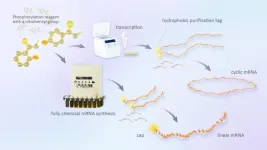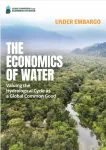(Press-News.org) In an era where viral outbreaks can escalate into global pandemics with alarming speed, the ability to quickly develop new vaccines has become crucial. However, the speed of vaccine production is limited because the mRNA used in it is partly chemically synthesized and partly synthesized using enzymes, a relatively slow process.
A team of researchers from Nagoya University in Japan has successfully developed an innovative synthesis technology capable of producing high purity, fully chemically synthesized mRNA, cutting out the slower enzyme reactions. This advancement establishes a foundation for more rapid reactions to viral outbreaks and emerging diseases, which will hopefully lead to mitigation of future infections at a preliminary stage. Their results were published in the journal Nucleic Acids Research.
Given its significant role in combating the COVID-19 pandemic, mRNA is now widely recognized for its potential to help prevent infectious diseases. Experts anticipate that in the future mRNA technology will be used to treat genetic disorders and emerging illnesses. However, producing mRNA remains challenging because of concerns about purity and production speed.
These problems can be addressed using fully chemically synthesized mRNA. According to Masahito Inagaki: “One of the most significant advantages of fully chemically synthesized mRNA is its ability to bypass the complex and time-consuming enzymatic reactions typically required in mRNA production. A method that relies purely on chemical reactions would significantly shorten the production process.”
It also offers benefits to people that have strong immune responses to vaccines. mRNA that is derived from 5'-monophosphorylated RNA is susceptible to contamination by incomplete RNA fragments, causing a strong immune reaction. This immune response increases the risk of side effects, particularly inflammation. However, existing purification technologies have struggled to remove these impurities, limiting its potential.
To address these issues, Professor Hiroshi Abe, doctoral student Mami Ototake, and Assistant Professor Inagaki devised a novel phosphorylation reagent with a nitrobenzyl group that serves as a hydrophobic purification tag.
Inagaki explained: “Nitrobenzyl groups have high hydrophobicity; therefore, when the nitrobenzyl group is introduced into the RNA molecule, the mRNA becomes more hydrophobic. As impure RNA lacks nitrobenzyl groups, it can be easily separated from the target RNA containing nitrobenzyl groups using reverse-phase high-performance liquid chromatography. This approach yields pure RNA, free from length inconsistencies and impurities typically associated with transcription-based synthesis methods.”
Besides fully synthesizing mRNA chemically, the team also created pure circular mRNA using the same method. Circular mRNAs are unique because they lack terminal structures, making them resistant to degradation by nucleic acid-degrading enzymes in the body, resulting in a longer-lasting medicinal effect.
The breakthrough in mRNA production has significant implications for the future of medical treatments. “This innovation paves the way for the highly efficient production of fully chemically synthesized mRNA and circular mRNA, which hold the potential to revolutionize RNA drug discovery and expand the scope of mRNA-based treatments,” Abe said.
Faster and purer vaccine production should improve our response times to future infectious threats. In the future, the team hopes to also use these results to develop new mRNA vaccines for cancer antigens and genetic diseases.
END
mRNA vaccines for disease outbreaks can be synthesized in less time with new technique
2024-10-17
ELSE PRESS RELEASES FROM THIS DATE:
UK health leaders urge chancellor to invest in a smoke-free UK
2024-10-16
Over 200 leading doctors, professional bodies and charities are urging the chancellor to use the budget on 30 October to invest in creating a smoke free UK as quickly as possible, and make the tobacco industry pay.
In an open letter published by The BMJ today, they warn that unless smoking is addressed, there is no prospect of delivering on Labour’s manifesto commitment to halve the gap in healthy life expectancy between the richest and poorest regions.
The rationale for investing to end the tobacco epidemic could not be stronger, they explain. The annual cost of smoking to individuals, public ...
No link to birth defects for potential fathers taking metformin for diabetes
2024-10-16
Potential fathers with type 2 diabetes can be reassured that taking the drug metformin is not associated with birth defects in their offspring, concludes a large study of more than 3 million pregnancies published by The BMJ today.
The researchers say the findings show that metformin can continue to be considered a suitable drug for managing blood sugar levels in men with type 2 diabetes who plan on having children.
Metformin is widely used to treat type 2 diabetes in men of reproductive age, but a recent Danish study reported a link between metformin use by fathers-to-be and an increased ...
For multiple sclerosis, medication and cognitive behavioral therapy can reduce fatigue
2024-10-16
In a study of commonly used treatments for people with multiple sclerosis, both medical and behavioral interventions, and a combination of the two, resulted in meaningful improvements in fatigue, a University of Michigan-led study finds.
The randomized clinical trial compared the effectiveness of modafinil, a wake-promoting medication used to treat sleepiness in people with sleep disorders, and cognitive behavioral therapy, or CBT, on reducing fatigue for over 300 adults with multiple sclerosis whose symptoms interfered with their ...
Children with multiple long-term conditions hospitalized with COVID are almost three times more likely to die: New study
2024-10-16
Individuals with multiple long-term conditions are two and a half times more likely to die following COVID-19 infection than others. When children were assessed separately the risk for mortality among those with multiple long-term conditions increased to almost three times (2.8) the risk of those without. The mortality rates are 22% and 8% respectively.
That is according to an authoritative systematic review and meta-analysis of over four million patients with COVID-19 published today (Thursday 17 October) in the Journal of the Royal Society of Medicine.
The authors are calling for patients with multiple long-term conditions ...
8% GDP loss by 2050 foreseen due to world water crisis; more than 50% of food production at risk: Global Commission on the Economics of Water
2024-10-16
Paris — An international group of leaders and experts warns that unless humanity acts with greater boldness and urgency, an increasingly out-of-balance water cycle will wreak havoc on economies and humanity worldwide.
In a landmark report, The Economics of Water: Valuing the Hydrological Cycle as a Global Common Good, the Global Commission on the Economics of Water says the water crisis puts at risk more than half of the world’s food production by 2050. It also threatens an 8% loss of GDP in countries around the world on average by 2050, with as much ...
Nanoparticle therapy offers new hope for prostate cancer patients
2024-10-16
Prostate cancer is the second leading cause of cancer death among American men.
A ground-breaking study, conducted by researchers from the University of Virginia, Mount Sinai, the University of Michigan, the University of Texas and others, has demonstrated the clinical success of a new nanoparticle-based, laser-guided therapy for prostate cancer treatment.
The study, which involved 44 men with localized prostate cancer, used gold nanoshellss in combination with magnetic resonance imaging (MRI) and ultrasound fusion — an ...
UVA researchers engineer AI breakthrough in human action detection technology
2024-10-16
What if a security camera could not only capture video but understand what’s happening — distinguishing between routine activities and potentially dangerous behavior in real time? That’s the future being shaped by researchers at the University of Virginia’s School of Engineering and Applied Science with their latest breakthrough: an AI-driven intelligent video analyzer capable of detecting human actions in video footage with unprecedented precision and intelligence.
The system, called the Semantic and Motion-Aware Spatiotemporal Transformer Network (SMAST), promises a wide range of ...
Bolstering the fight against antibiotic-resistant bacteria
2024-10-16
GAINESVILLE, Fla. — University of Florida Health scientists exploring how combinations of antibiotics can fight resistant bacteria have been awarded an $11.8 million grant for work that could help save the tens of thousands of lives lost yearly to infections that are increasingly plaguing humanity.
The National Institutes of Health, or NIH, grant to the UF College of Medicine and the UF College of Pharmacy will support scientists working to uncover the mechanics of how bacteria and antibiotics interact, down to the molecular level.
That mechanistic knowledge ...
Deep learning illuminates atmospheric blocking events of past, future
2024-10-16
Atmospheric blocking events are persistent, high-impact weather patterns that occur when large-scale high-pressure systems become stationary and divert the jet stream and storm tracks for days to weeks, and can be associated with record-breaking flooding or heat waves, such as in Europe in 2023. In a new study, University of Hawai‘i at Mānoa atmospheric scientist Christina Karamperidou used a deep learning model to infer the frequency of blocking events over the past 1,000 years and shed light on how future climate change may impact these significant phenomena.
“This study set out to extract a paleoweather signal from ...
Kidney transplantation among those with HIV infections shown safe and effective
2024-10-16
It is just as safe and effective for people with HIV in need of kidney transplantation to get their organ from donors who are also HIV positive as it is from donors who are not infected with the virus, a new study shows. Survival rates for organ recipients one and three years after the procedure were the same for donors with or without HIV. Also the same were risks of serious side effects, such as infection, fever, and rejection in the donated organ.
In what is the largest comparative trial of the experimental procedures since the first transplant was performed in the United States in 2016, researchers ...




